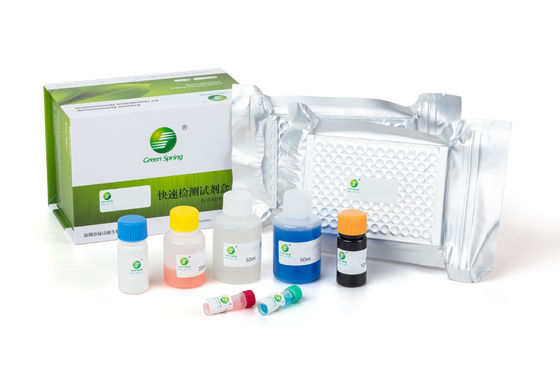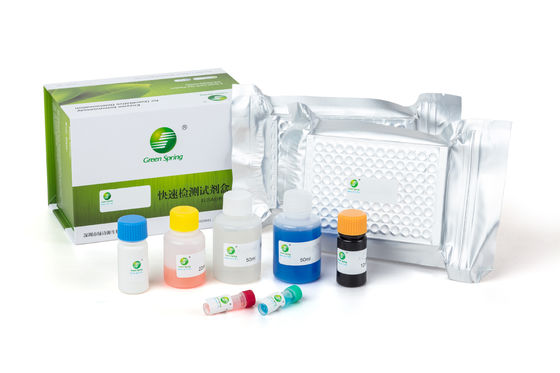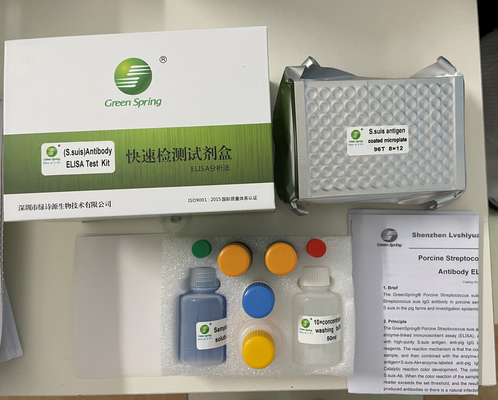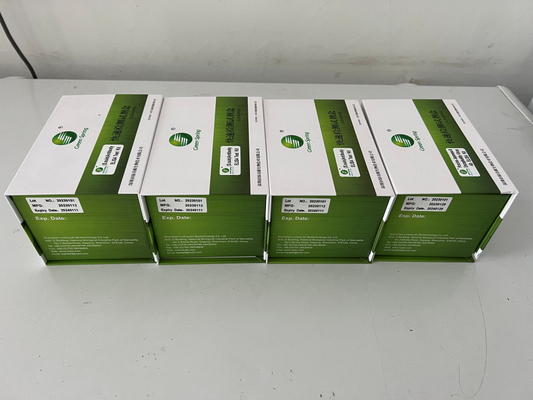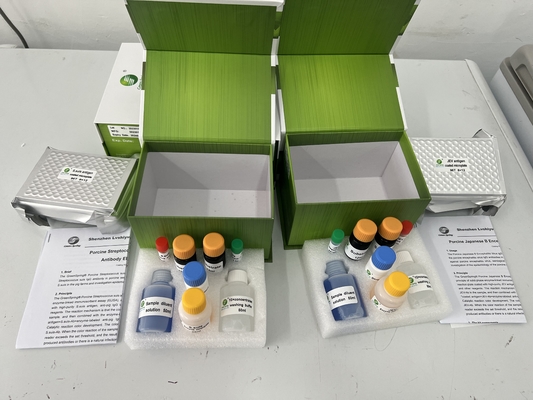|
|
Competitive ELISA Kit for Detecting Antibody of Foot and Mouth Disease Virus subtype A
Product Details:
Payment & Shipping Terms:
|
| Packing: | 2 Plates/kit | Shelf Life: | 12 Months When Store At 2~8℃ |
|---|---|---|---|
| Incubation Temperature: | 37℃ | Incubation Time: | 30min-30min-10min |
| Sample Performance: | Pig Serum |
Competitive ELISA Kit for Detecting Antibody of Foot and Mouth Disease Virus type A
Catalog No. LSY-30034
1. Usage
This kit is suitable for antibody monitoring and immune effectiveness evaluation in immunized areas. Applicable to pigs, cattle, goats and sheep.
2. Principle
This kit adopts the competitive ELISA method to detect type A neutralizing antibody, and the ELISA plate is coated with FMDV-A VP1 recombinant protein antigen, and the anti-VP1 protein monoclonal antibody is the enzyme marker. Add the serum to be tested to the antigen-coated plate, and then add the enzyme-labeled monoclonal antibody. If there is FMDV-A-specific antibody in the serum to be tested, it will compete with the enzyme marker for the antigen in the coated plate, and the unbound components will be blocked. Wash off, the color is light or no color after adding the substrate. Conversely, the color was darker after adding the substrate. Use a microplate reader to measure the OD450nm value, and determine the experimental results according to the calculation formula.
3. The kit components
| 1 | FMDV-A antigen coated microplate | 96T X 2 | |
| 2 | FMDV-A Enzyme conjugate | 12 ml | yellow lid |
| 3 | Sample diluent | 12 ml | transparent lid |
| 4 | FMDV-A Negative control | 1.5 ml | green lid |
| 5 | FMDV-A Positive control | 1.5 ml | red lid |
| 6 | Substrate | 12 ml×2 | orange lid |
| 7 | Stop solution | 12 ml | blue lid |
| 8 | 10×concentrated washing buffer | 50 ml | white lid |
| 9 | Adhesive Foil | 2 pieces | |
| 10 | Instruction | 1 piece | |
4. Materials Required But Not Provided
1) Microplate Reader (single-wave length: 450 nm).
2) Precise micropipette (single-channel 10-100ul,0.5-10ul,multi-channel 30-300ul)
3) Constant temperature box or water bath box.
4) Oscillator.
5) Disposable tips (10ul, 200ul)
6) Deionized water
5. Sample requirement
Try to use freshly collected serum samples; It cannot be used to detect samples with serious pollution or hemolysis; If the serum sample is turbid, take the supernatant after centrifugation for detection; The test sample can be stored at 2 ~ 8 ℃ for 5 days. If it is stored for a long time, it needs to be transferred to - 20 ℃ or lower temperature.
6. Preparation
1) Bring ELISA reagents to the room temperature (25±3℃) for at least 30 min to get best results. Microplate should return to room temperature and dry before open package.
2) Washing buffer preparation: Dilute the 10×concentrated washing buffer with deionized water at 10 times. (for example: 10ml 10×concentrated washing buffer + 90ml deionized water ).
7.Procedure
1). Add sample: add 50 µL of negative control serum (NC) and 50 µL of positive control serum (PC) to the control wells; firstly add 40 µL of sample diluent to the sample wells, then 10 µL of serum to each well; add 50 μL of Enzyme conjugate to each well, gently shake to mix (do not spill), cover with sealing film, and incubate at 37°C for 30 min.
2). Wash the plate: discard the liquid in the well, add 300 μL of diluted washing buffer to each well, and wash three times. After the last wash, gently pat the ELISA plate dry on absorbent paper. It is strictly forbidden for the well plate to dry between steps.
3). Add Substrate: Add 100 μL of Substrate to each well, mix gently, cover with sealing film, and incubate at 37°C for 10 min in the dark.
4). Termination: Add 50 μL of stop solution to each well, shake for 10 seconds, mix well, and read after termination.
5). Reading: Use a microplate reader to measure the optical density value (OD value) at a wavelength of 450nm.
8. Results
- For the assay to be valid, average OD value of Positive control <0.4, average OD value of Negative control >0.6.
- Calculation method: ODNC Average value = (ODNC1+ODNC2)/2
- Sample S/N value calculation formula: S/N=Sample OD value/ ODNC Average value
- Judgment standard: S/N≤0.5, judged as positive; S/N>0.5, judged as negative.
9. Precautions and warnings for users
1) Read the Manual carefully before use.
2) Do not use reagents expired, do not mix reagents from different lots.
3) Experiment rubbish should be dealt with high pressure steam sterilization at 121 ℃ for 30 minutes, or treated with 5.0g/L sodium hypochlorite disinfectant for 30 minutes, then discard.
4) MicroWell plate removed from the refrigerated environment should be balanced moisture to dry at room temperature, then can be opened. Put back unused MicroWell plate into dry foil bag and sealed at 2-8 ℃. Unused liquid reagent should cover caps, store at 2-8 ℃ in dark with other group components.
5) Should use Micropipettor to add sample and reagents, and often proof its accuracy.
6) When adding washing buffer, should be full but no overflow, avoid appearing free enzyme at mouth of well or cross pollution between wells.
7) Stop solution is corrosive, use large amount of water to wash immediately when touch the skin or clothes.
Specifications: 96 wells×2.
Expiry date: 12 months.
Storage: Store at 2~8℃, in the dark, no freezing.
Production Date: On outer-packing of the test kit.
For veterinary diagnostic use only
Shenzhen Lvshiyuan Biotechnology Co., Ltd
D Building, National Biological Industrial Park of Marinelife, No.2 Binhai Road, Dapeng, Shenzhen, 518120 China
Tel. 86-755-28438788
Fax 86-755-28938800
Email: info@lsybt.com
www.lsybt.com
![]()
![]()
![]()
-
Canine/ Feline/ Rabbit/ Rat Toxoplasma gondii IgG antibody ELISA kit TOXO Ab
-
Foot and mouth disease virus (FMDV) Type O Antibody Test (block ELISA) animal diagnostic kits
-
Gumboro Disease (IBD) Virus Antibody test kit infectious bursal disease elisa
-
Infectious Bronchitis(IB) IgG antibody diagnostics kit poultry elisa test
-
Avian Marek's disease virus antibody ELISA test veterinary diagnostic kit for mareks
-
Avian EDS76 antibody ELISA kit egg drop syndrome detection



